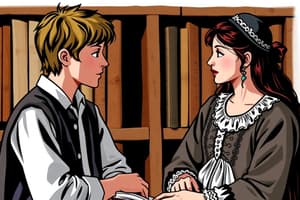Podcast
Questions and Answers
What distinguishes a flat character from a round character in a story?
What distinguishes a flat character from a round character in a story?
- Flat characters are always the protagonists, while round characters can only be antagonists.
- Flat characters often symbolize deeper themes, while round characters do not.
- Flat characters have a single, distinct personality and do not change significantly. (correct)
- Flat characters undergo major changes while round characters remain static.
What role does the antagonist play in a story?
What role does the antagonist play in a story?
- The antagonist is always a human character within the story.
- The antagonist represents the obstacles that the protagonist must face. (correct)
- The antagonist is a character without any impact on the protagonist.
- The antagonist provides resolution to the protagonist's conflict.
Which character type would best describe Gandalf from The Lord of the Rings?
Which character type would best describe Gandalf from The Lord of the Rings?
- Flat character due to his unwavering role in the narrative.
- Symbolic character who embodies the archetype of the wise mentor. (correct)
- Round character as he experiences significant development throughout the story.
- Stock character defined by his uniqueness and lack of recognition.
In literary terms, what is a theme?
In literary terms, what is a theme?
What is a stock character known for in narrative literature?
What is a stock character known for in narrative literature?
What is the primary role of the author in a story regarding the plot?
What is the primary role of the author in a story regarding the plot?
Which plot development structure starts from the end and works backwards?
Which plot development structure starts from the end and works backwards?
What element of a story is crucial for revealing the experiences and thoughts of characters?
What element of a story is crucial for revealing the experiences and thoughts of characters?
In which part of the plot does the tension usually culminate?
In which part of the plot does the tension usually culminate?
Which type of plot development aims to surprise readers through non-linear timelines?
Which type of plot development aims to surprise readers through non-linear timelines?
Flashcards are hidden until you start studying
Study Notes
Character
- Characters represent the human aspect of literature, but can also include animals, objects, places, or events.
- Development occurs through dialogues and progression over the story.
General Classifications
- Protagonist: Central character, typically with positive traits, faces conflict, and seeks resolution.
- Antagonist: Character(s) that create conflict for the protagonist, representing obstacles.
Types of Characters
- Flat Characters: One-dimensional, consistent traits, undergo minimal or no change.
- Round Characters: Multi-dimensional, evolve significantly throughout the plot.
- Stock Characters: Recognizable figures from narrative styles, often remembered for their prominent roles.
- Symbolic Characters: Represent significant themes or archetypes, like Gandalf or Dumbledore embodying wisdom.
Theme
- Themes represent significant ideas or lessons derived from a story, often inferred by readers.
- Common themes include honesty, love, faith, courage, and compassion.
Plot
- Refers to the sequence of events within a story, usually structured as beginning, middle, and end.
- Beginning: Introduces main character and conflict, creating suspense.
- Middle: Introduces complications faced by the protagonist, increasing tension.
- Climax: The peak of the story's drama, where conflict reaches its highest point.
- Denouement: Resolution of the conflict, whether it leads to triumph or tragedy.
Types of Plot Development
- Chronological: Events arranged in the order they occur, straightforward narrative.
- Reverse: Storytelling starts from the end and moves to the beginning, less common.
- Multiple Flashbacks: Begins chronologically but revisits earlier events, creating a layered narrative.
- Out of Sequence: Non-linear narrative showing various perspectives, often hiding plot twists.
Point of View
- Crucial for how readers perceive the story, involving the narrative perspective chosen by the author.
- Determines the voice and lens through which the story is conveyed.
Studying That Suits You
Use AI to generate personalized quizzes and flashcards to suit your learning preferences.




